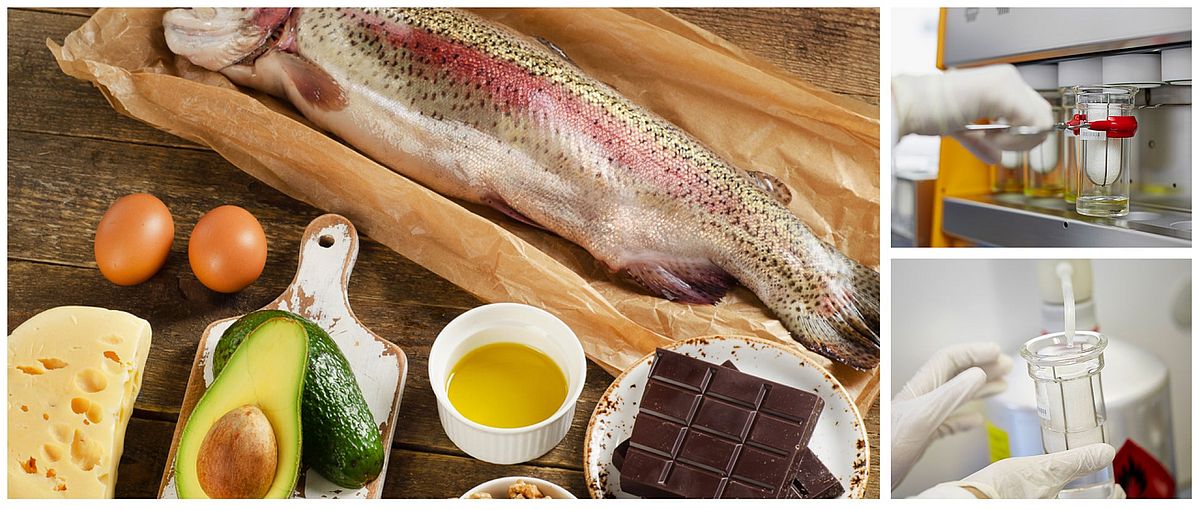Dioxins in food
In common language, the term dioxins covers several organic compounds that belong to the group of chlorinated dioxins (PCDD) and chlorinated furans (PCDF). Together with the dioxin-like polychlorinated biphenyls (PCBs), these in turn belong to the group of persistent organic pollutants (POPs). POPs are highly toxic pollutants that degrade only very slowly in nature. They are usually produced as unwanted by-products of thermal and industrial processes, such as incineration plants, forest fires or domestic fires. Despite the relatively low natural occurrence of dioxins and PCBs, they can be quite dangerous for humans. Since they are fat-soluble or lipophilic, they accumulate in the fat tissue of humans and animals and can reach higher concentrations in the course of the food chain. Humans, for example, absorb dioxins mainly through animal products such as meat, eggs, fish or milk. Since dioxins and PCBs degrade only very slowly, dangerous amounts can accumulate in the human body and cause cancer, among other things. For this reason, strict limits for dioxins and PCBs in food and animal feed now apply worldwide. According to the WHO, the tolerable daily intake is e.g. 1 - 4 pictograms per kilogram of body weight. Within the framework of food monitoring, food and feed are therefore examined by public authorities for dioxin contamination. But food processing companies are also obliged to document the quality of the raw materials used within the scope of their own inspections. Often, breast milk is also tested for dioxin contamination, which is used, among other things, as a reference for the dioxin contamination of the population as a whole. Since dioxins and PCBs are fat-soluble, SOXTHERM as a system for fat determination is ideally suited for sample preparation for the subsequent analysis of dioxins and PCBs by means of gas chromatography (GC) and mass spectrometry (MS).
Determination of dioxins in food
Sample preparation:
Shredding and homogenisation of the sample with a suitable method to a particle size of approx. 1 mm. In addition, the samples are dried by trituration with sodium sulphate and sea sand.
Wheighing:
A representative portion of the sample is weighed directly into the pre-extracted extraction thimble to the accuracy of ± 0.1 mg and covered with pre-extracted cotton wool. Depending on the detection method, an internal standard must be weighed in for quantification.en.
Extraction:
After adding a suitable solvent, the sample is extracted either classically in a Soxhlet apparatus or time-efficiently in the SOXTHERM (~1-2h).
Purification:
After successful extraction, the residue in the extraction beaker is purified by suitable purification procedures (e.g. gel permeation chromatography (GPC) or high performance liquid chromatography (HPLC)).
Detection:
The purified sample is analysed by a suitable detection method (e.g. GC-(HR)MS).
Alternative method with HYDROTHERM and SOXTHERM
An alternative experimental method for sample matrix independent determination of dioxin content has been developed in collaboration with the Food and Drug Administration (FDA). Further information can be found in the following publication:
J.C. Archer, R.G. Jenkins Jr., J. Chromatogr., 2017,B 1041–1042, 70–76.
Analytical results for zinc oxide
| Congeners | Standard deviation | Recovery |
|---|---|---|
| 2,3,7,8-TCDD | 0.025244467 | 87.66810345 |
| 1,2,3,7,8-PeCDD | 0.175425676 | 111.234375 |
| 1,2,3,4,7,8-HxCDD | 0.268234535 | 85.74002217 |
| 1,2,3,6,7,8-HCDD | 0.187068963 | 90.55260047 |
| 1,2,3,7,8,9-Hexa CDD | 0.344476386 | 86.66143822 |
| 1,2,3,4,6,7,8-HpCDD | 1.764433337 | 88.06133625 |
| Octa CDD | 1.812959425 | 99.89959839 |
| 2,3,7,8-TCDF | 0.102194419 | 95.92411839 |
| 1,2,3,7,8-PeCDF | 0.614111083 | 111.1676578 |
| 2,3,4,7,8-PeCDF | 1.32486836 | 95.55419781 |
| 1,2,3,4,7,8-HxCDF | 3.427227606 | 98.68334213 |
| 1,2,3,6,7,8-HxCDF | 1.636451358 | 97.90557404 |
| 2,3,4,6,7,8-HxCDF | 2.229423535 | 113.8436939 |
| 1,2,3,7,8,9-HxCDF | 0.539590035 | 91.12525458 |
| 1,2,3,4,6,7,8-HpCDF | 2.251761463 | 117.1330846 |
| 1,2,3,4,7,8,9-HpCDF | 2.54736345 | 109.4093407 |
| Octa CDF | 4.344917424 | 118.5165006 |


![[Translate to English:] [Translate to English:]](/fileadmin/Redaktion/Freigestellte_Produktbilder/web_pic_soxtherm_6_450x450px.jpg)